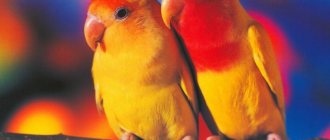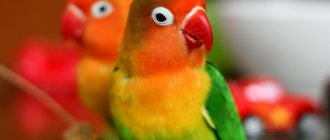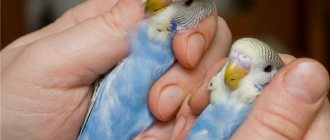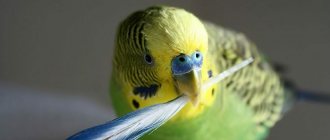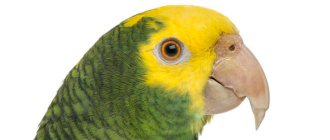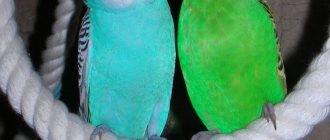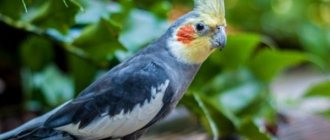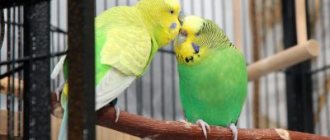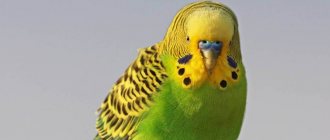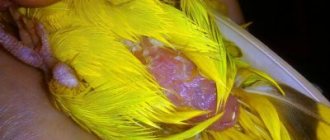Choosing a parrot to buy is a very responsible and difficult matter. A mistake will result in a waste of money. A good choice will lead to many years of pleasure from communicating with your pet.
It is common knowledge that the budgerigar you purchase should be as young as possible. A chick adapts to a new owner much faster than an adult bird. He learns to talk faster. Often sellers deceive buyers by passing off an old bird as a young one. Therefore, the questions - how to distinguish a young budgie from an old one and how to determine the age of a parrot - are far from idle questions.
Plumage
How to find out the age of a budgerigar by its plumage? At one and a half months, the chick has already formed its plumage; at this age, the parrot should be, as they say, “feather to feather.” In the case when the seller claims that the feathers have not yet “fully grown”, this should be confusing, since perhaps the bird is simply sick or old. The plumage of young individuals is less contrasting than that of adults and is dull. However, with age it becomes brighter and clearer. At 4-6 months, parrots shed their “chick plumage” and acquire mature plumage.
How to distinguish a young bird from an old one
Before buying a new pet, it is recommended to study a simple table based on which the age of the parrot is determined.
| Bird age | Signs |
| Up to 1.5 months | The beak is black, a wave-like pattern on the head next to the cere, round and black eyes without an iris |
| From 1.5 to 3 months | Black eyes without a clear iris, wave pattern on the head, yellow beak |
| 3 to 4 months | Black eyes, unattractive plumage associated with the beginning of the first moult, displacement of the wavy pattern to the back of the head from the wax |
| From 4 to 8 months | The iris becomes light, and a clearly visible “cap” appears on the head together with chaotic waves. |
| Over 8 months | Bright white irises and a formed “cap” on the head. |
After 8 months there are no visible external changes in the birds. Therefore, if you need to purchase a young individual, you will have to focus on the above signs.
Ability to fly
Budgerigar chicks are already able to fly at about the age of 1 month. Although the plumage is still being formed, it is already enough for the first flights. Therefore, if the seller claims that the chick “has not learned to fly yet,” this should be alarming. Especially if you consider that the chick that is being sold must be more than 1 month old, the most suitable age is 40-45 days.
Differences in characteristics between males and females
When choosing a parrot, it is advisable to take into account its gender, and this is especially important if you plan to buy a pair and breed birds in the future. Knowing the gender, it is much easier to determine the age of the bird.
These features include:
- in small females, the thickening above the beak has a pink, blue or purple tint;
- in adult girls, the cere becomes darker and also acquires a brown color;
- Boy parrots have a light purple wax color;
- in older boys, the upper part of the beak has a dark purple tint.
If you plan to buy pure or variegated budgies, then they retain the same wax color at any age, so this method is not suitable for determining age.
Young male Young female Adult male Adult female
The average lifespan of a parrot is 10 years . 5-year-old birds are practically no different from 10-year-old birds. It is easiest to determine the age only in the first year of a bird’s life. It is important to know about the main characteristics of the young in order to select a chick, since it is easy to accustom it and teach it to speak.
Question: How old is a parrot by human standards? Answer: 1 year of a parrot's life is equal to approximately 7 years of a human life.
Exceptions
Budgerigars come in different colors, sizes and types. There are even specially bred mutation breeds called “inos”. Additionally, you can choose a pure or recessively variegated parrot. When determining their age, it is not possible to use standard methods.
This is due to the following features:
- representatives of mutation breeds retain black eyes and irises for life;
- if albinos are selected, they have red eyes from birth;
- parrots of these breeds rarely have a black beak even at a young age;
- these birds do not have waves on their heads, since they have a uniform color;
- males forever retain the blue or light pink color of the wax.
Unusual parameters are present not only in mutation breeds, but also in ordinary wavy breeds. In the first months, they may develop a white iris or a “cap” on their head. Such tricks and features are often used by careless sellers, and deception is usually found at the poultry market.
To avoid buying an old bird, it is recommended to contact trusted breeders . They sell birds with special rings that indicate the date the chick was born, as well as the nursery and country of origin. Such rings are put on chicks at the age of 9 days, but only solid and non-removable products are used.
It is also useful to read: Pros and cons of a budgie
Determining the age of a parrot
Young wavy animals differ in appearance from mature ones. It is not so difficult to understand where the chick is and where the bird is older than a year. But only a professional can figure out how many years a parrot has lived - five, ten or fifteen. It is easier to be sure of the age of the ward if there is a ring on his paw. A bird from a nursery is banded in the first days of life. The ring is usually engraved with the date of birth.
This is interesting: the ring on a bird’s foot is a kind of document, like a birth certificate.
Adult or young parrot: main differences
Young parrots, no older than four months, have a “zebra” pattern on their heads, going straight from the wax. It can be noticeably expressed or blend in with the color of the feathers. This feature disappears after the first (juvenile) molt at three months. If this process is delayed, then a six-month-old parrot may be mistaken for a very young bird. The wavy pattern disappears gradually, being replaced by a fluffy “hat” of the parrot by three months of life.
Important: the process of changing plumage slows down in conditions of poor bird care, or in a situation of prolonged stress in the bird
Another sign is the color of the beak. A 2-month-old budgie has a black beak or nose with dark spots. However, in light-colored breeds (albinos or lutinos), the beak becomes lighter already at 20-25 days of age. By 4-6 months, the bird’s nose becomes greenish or yellowish.
Chick parrots have black eyes, while mature birds have a white ring surrounding the pupil. A pronounced iris around the bird’s pupil “signals” that the parrot is at least six months old. The iris is absent not only in “young” birds, but also in individuals with a mutation color, in which the eyes remain black or red forever. Older budgies may not have feathers in the eye area.
The age of a budgerigar is also determined by the tone of the wax: pink-violet, blue and white, beige, or the presence of all shades, indicating that the female has not yet reached 2.5 months. Later, the cere will turn white, beige or bluish (at 4-5 months - brown). By its color, you can determine not only the age of the female budgerigar, but also its readiness for mating. In a sexually mature girl who is ready to reproduce, it is brown, and if the bird’s body is not ready for procreation, it is beige.
A young male budgerigar has a pink cere, sometimes with a purple tint. After the first change of feathers, she will turn blue. But in pure male parakeets, albino, lutino and variegated species, the light pink tint will remain.
Feeding the bird
Proper nutrition directly affects the lifespan of a budgie. In order not to undermine the health of the bird, it is important to take the issue of feeding it seriously. The basis of the diet is millet (yellow, white, red), oats, seeds of wild plants and sunflowers. Every other day, soft food is included in the pet’s diet: finely chopped boiled egg, grated nettle, grated carrots or beets, homemade cheese. If the female is incubating eggs, a soft mixture must be given daily. From time to time, parrots are treated to a peeled apple.
In winter, sprouted grains are especially useful for birds; they replenish the deficiency of vitamins and minerals. In summer, it is recommended to give lettuce, parsley, and dandelion leaves. If possible, willow branches, previously scalded with boiling water, should be placed in the cage.
Why do budgies live short lives?
Strictly speaking, the life resource of these birds is quite significant, although less than that of other representatives of the order. With proper maintenance, wavy plants can delight owners for 8 to 11 years.
The following factors reduce the lifespan of a parrot:
- lack of adequate nutrition and quality drinking water;
- improperly selected cage and dangerous environment;
- lack or untimely veterinary care;
- family members either do not communicate with the parrot at all, or the contact is stressful or aggressive;
- inappropriate light and temperature conditions;
- insufficient physical activity;
- loneliness, life without a partner.
With proper maintenance, a budgie can become a faithful companion and full member of your family for many years.
Reasons why a budgerigar does not live long
Lifespan
The average lifespan of a wavy is approximately ten years. However, under favorable conditions, a healthy pet will remain with the owner for a longer period. There are cases where the wavy lived up to 18 years. The lifespan of a parrot largely depends on nutrition, regular cleaning of the cage and the absence of diseases. The bird must be regularly released into the room, because under natural conditions, wavy birds fly vast distances every day.
An exception
While it is quite possible to determine the age of a standard parrot, problems will arise with other varieties of budgerigars. These include:
- lutino and other foreign varieties;
- repressive-variegated individuals;
- albinos;
- pure parrots.
Budgerigars with mutations have characteristic features that significantly complicate the determination of the age characteristics of the bird and, in some cases, make this task impossible. For example, lutino and albino budgies have red eyes with dark scarlet irises. Moreover, both chicks and adults have this feature.
If you are thinking about how to find out how old a pure-bodied or repressive-variegated budgerigar is, it is useless to pay attention to the individual's wax. In males of these breeds, the suprabeak formation remains unchanged throughout their lives. However, in females, the color of the wax usually changes by six months.
In light-colored parrots or individuals with foreign mutations, the beak loses black pigments within a month after the birth of the bird, and in some chicks the black pattern is absent initially. The same can be said about the patterned pattern on the “cap”, which is deprived of celandine wavy flowers.
How to choose and arrange a cage
The correct choice and arrangement of the house affects how long budgerigars live in a cage.
For a bird, you can purchase a cage of any shape and size. The most preferable is rectangular with a dome-shaped top. The lower part should be made of wood or metal, and the side walls should be barred with strong thin rods. Birds often chew on wire, so it is better to avoid a copper cage, which can cause oxide poisoning. If the pallet is made of soft wood, the parrot will easily peck holes in it and you will need to purchase a new cage. In order to satisfy the bird's reflex, it is recommended to install thick tree branches in the cage.
The minimum dimensions of a cage for one individual should be at least 35 by 35 cm, and for a pair of birds - 65 by 55 cm. The height of the home is not so important, since parrots only climb in it. The bars should be spaced close enough so that the bird cannot stick its head between them and injure itself. At the same time, too many rods are also undesirable; they make it difficult for parrots to see the room.
It’s not enough to just choose a cage, you need to arrange it correctly. Several perches are placed in it away from the drinking bowl and food bowl, and the pet’s tail should not touch the bars of the wall.
The cage is also equipped with a hanging swing or a freely swinging ladder. Such devices contribute to the development of the muscles of the feathered legs. There are three feeders in the cage: for water, mineral supplements and main food.
Diseases
Owners often encounter diseases when keeping birds. The pathology is manifested by the appearance of a growth on the beak of a budgerigar, plucking of feathers, refusal to eat, and decreased activity.
What could be the reason:
- Poisoning. At the first signs of poisoning, the bird is given a tablet of crushed activated carbon with water or a decoction of flaxseed.
- Tumor. This type of parrot is prone to tumor diseases, which develop rapidly and are very poorly treated.
- Iodine deficiency.
- Fractures of wings and legs. Occurs due to strong impacts or falls from a height.
- Shake. As a rule, a bird gets it when it hits a mirror or glass. When a bird has a concussion, it exhibits strange behavior: it staggers, actively shakes its head, and eats poorly.
- Colds. Warm-loving birds react strongly to drafts and viral infections. When infected, they experience symptoms similar to humans. After suffering from the flu, your pet can get a serious heart complication.
You should not try to cure your pet parrot on your own. If the first symptoms of one of the listed diseases occur, you must seek qualified help.
Air humidity
How long birds live is also affected by the humidity in the room. A person needs to provide it at a level as close as possible to the natural habitat of budgerigars. In their homeland, Australia, rain is an infrequent occurrence, however, air humidity ranges from 55-70%.
If the air in the place where the birds are kept is dry, the pets will develop skin diseases, the feathers will become brittle and begin to fall out, and the molting period will be prolonged. Moreover, the condition of parrots worsens, the risk of viral and respiratory diseases increases, the immune system weakens, and the mucous membranes of the nose, eyes and mouth dry out. To avoid such consequences, it is imperative to install a bath of water in the bird’s cage. Budgerigars love water treatments.
